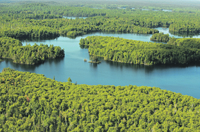The Canadian Boreal Forest Agreement, billed in May by participants as “historic,” appears to be constructed of a set of boxes within boxes. It is, says Aran O’Carroll of the Canadian Parks and Wilderness Society (CPAWS), an agreement between some major environmental organisations and most of the Canadianboreal forest industry on “how we are going to work together for three years.” However, critics say it could also be characterised as a deal between private partners over public and First Nations lands.
The Forest Products Association of Canada (FPAC) has agreed that its members will not log, build roads, or plan logging on 29 million hectares of woodland caribou habitat before March 2012. Both O’Carroll and Avrim Lazar of FPAC agree that the companies had no plans to log much of that area in that time, only 72,205 hectares, according to Dawn Paley in one of the first critiques of the deal published in The Dominion (www.dominionpaper.ca).
In return, the environmental organisations have pulled their markets and investor campaigns. The two sides have committed to a conservation planning process for protected areas and caribou habitat. Ecosystem Based Management (ESM) for the entire 72 million hectares of FPAC tenures is to be initiated by December 2012, with an expert panel selecting the most rigorous elements from among three certification schemes, including Forest Stewardship Council (FSC) Canadian boreal standards. The binding panel process was designed to “avoid the gridlock that the Great Bear Rainforest deal has encountered,” said CPAWS’ O’Carroll, saying that at least the deal gives caribou a chance to survive. Other mutual goals include some greenhouse gas accounting, and the “improved prosperity of the Canadian forest sector and the communities that depend on it.”
The eco-signers agreed to actively promote boreal forest products if the terms of the deal are completed. Both sides, stressing the unique nature of this collaboration, have agreed to mutual aid in the event of attacks from their colleagues. Upon questioning, however, a small crack appeared in the facade of “peace in the woods.” Lazar, a former Environment Canada bureaucrat, assured the Watershed Sentinel that achieving ESM is easier than in the rainforest because the boreal is simpler: fire disturbance means there is no old growth and the average age of the forest is only 60 years. O’Carroll, however, said, “There is lots of old-growth and intact forest in the boreal.”
Tellingly, both agreed there would be little or no decline in the cut rate; Lazar pointed out this would violate the Agreement’s protection of the forest sector’s economy. O’Carroll expressed the expectation that the Agreement would “shift the harvest around” but allow for “no reduction in harvest.” Even if the current cut rate of about 1% a year is unsustainable, if the companies live up to their side of the deal, the eco-groups will be bound to promote Canadian boreal forest products.
However laudable the Agreement, and whether or not it is ever realised (or realisable) on the ground, the deal certainly has the fingerprints of big money all over it. According to the press release, “Environmental Organizations Participating in the Agreement are Canadian Boreal Initiative, Canadian Parks and Wilderness Society, Canopy (formerly Markets Initiative), David Suzuki Foundation, ForestEthics, Greenpeace, Ivey Foundation, The Nature Conservancy, and the Pew Environment Group’s International Boreal Conservation Campaign.” The Hewett, Ivey, and Pew foundations helped pay for the process and some, if not all, of the mapping; Ivey and Pew signed on to the deal as “environmental organisations.” The Canadian Boreal Initiative is the secretariat to the Boreal Leadership Council, consisting of some big eco-groups, First Nations, resource companies and their investors, and it signed on to the deal as an environmental organisation. By the way, Pew Charitable Trusts footed the bill for the FSC Canada Boreal Standard, judging from the acknowledgement on the actual standard.
Provincial governments appeared to approve of the deal, but First Nations across Canada reacted with alarm, from a multitude of viewpoints. It is unclear how this method of negotiating jibes with the FSC principle of a duty to consult and come to agreement with indigenous inhabitants of the forest. Negotiations will definitely be ongoing.
***
[From Watershed Sentinel, Sept/Oct 2010]


